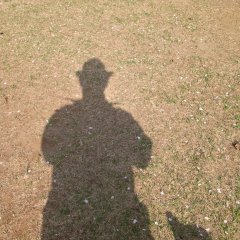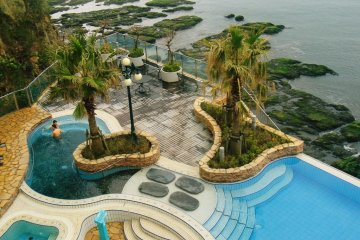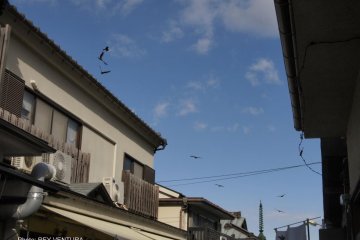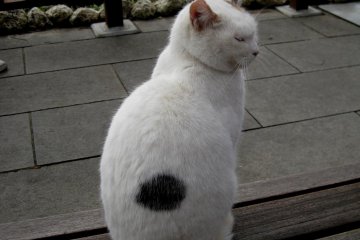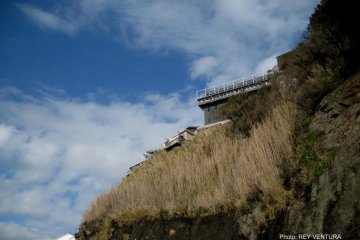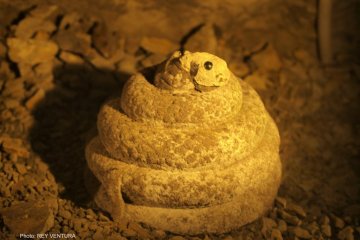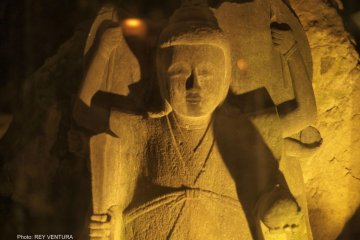It's the Year of the Water Snake. And this year, the first snake that stared at me with its immovable burning eyes was a sculpted stone serpent meditating in the deepest bowels of Iwaya Caves in Enoshima.
The four-kilometer in circumference island of Enoshima, a part of the city of Fujisawa, may not be as ‘branded’ a place as its illustrious and UNESCO World Heritage Site applicant neighbor Kamakura City but it has got its own charms and elegance.
From Yokohama where I live, it takes about thirty minutes on the Tokaido and Enoden Lines to get there. But I prefer to cycle to the historical and mythical island. It takes about two hours. On foot, which I have tried two times, I can arrive in three hours.
During the holiday season, on a very windy and cold day, on the third day of the first month of the year, I cycled again to the once upon a time exclusive and sanctuary island.
Through the introduction of a friend, I came to discover the island where Benzeiten, the goddess of river, eloquence and knowledge is enshrined. My friend said: “At Enoshima you can watch the sun setting behind Mt Fuji from the Pacific Ocean while drinking beer on a cliff." Romantic that I am, I immediately set a date for a visit. That was ten years ago.
I have crossed the 600-meter bridge that connects the island to Fujisawa City over a dozen times since then. I always take the slow-moving Enoden train from Fujisawa Station as it meanders and snakes through the picturesque gaps of houses to Enoshima Station. I keep going down to the enchanted island for several reasons:
First, in addition to Mt Fuji and the sunset, my interests have become wider and wilder. I have been drawn into the mystery of some of its exotic inhabitants. Foremost of these are its cats -- the famed Enoshima Cats. Enoshima Cats are the fattest cats I've ever seen in Japan. They are as fat as the meditating Buddha, as friendly as a saleslady at a department store in Yokohama, and as intelligent and creative as a lady independent journalist. These wild cats respond to your greetings and instructions like obedient pupils. They try to engage you in a conversation in their own unique eccentric way.
Another interest is tombi-watching. These omnipresent black kites (hawks) hover over the island and the numerous restaurants and souvenir shops looking for someone's food to grab off. These carion's of prey are like guerillas. If you are not watchful, in an instant they could ambush you, dart in and fly off with your manju (bun with filling) or sembe (rice cracker) or onigiri (rice ball). Once I tried offering them a rice ball wrapped with seaweed and filled with pieces of salmon. I placed the fist-sized triangular onigiri on top of a post. I wanted to photograph these birds at close range. But they were too smart and too proud. They wouldn’t take anything offered them. Instead, they want to play a game. When you are not looking, in your unguarded moment, at the speed of lightning, they come and steal your food!
But at their best, they delight you as they soar and glide between the darkening sky and the wide, wide sea. Before the majestic gaze of Mt Fuji they fly low and slow and circle the island and occasionally perform tricks. They are inspiring. Watching them fly with grace and freedom makes me want to become a hawk like them.
And of course, before leaving the island, your stomach must be filled. Otherwise, as the Great Buddha warns, an empty stomach will make you full of desire. And desire would lead you astray and off the path. Therefore, at the last and least expensive eatery perched on the western edge of the cliff, I sat down for lunch. I ordered a tandem of shirasu-don -- a bowl of rice topped with fresh shirasu (whitebait sardines) and a bottle (it became two) of dark Enoshima Beer.
Warmed and a little inebriated, I continued to walk down and crossed the walk-bridge to the Iwaya caves. Inside the newly renovated cave-museum, among other gods, I met Benzaiten for the first time. Many young people consider her as a goddess of love. Young lovers come here to wish and pledge for eternal love. Not far from this quiet multi-armed goddess are some stone snakes under spotlights. I was born in the Year of the Tiger and I have heard that tigers and snakes are not the best of friends. Nevertheless, I whispered to Benzaiten for a harmonious family relationship. Like Benzeiten, the goddess of beauty, she co-exists peacefully with the numerous serpents in the caves.
I walked out of the caves past five. Dark clouds had already blanketed the sky. But in the distance, there was a small opening through the curtain of clouds: Mount Fuji was fast fading away beautifully. Legend has it that the Iwaya caves provide a secret passage to Mount Fuji. Perhaps, I thought, under the seabed, there’s a tunnel that leads the blessed traveler to the sacred mountain.


